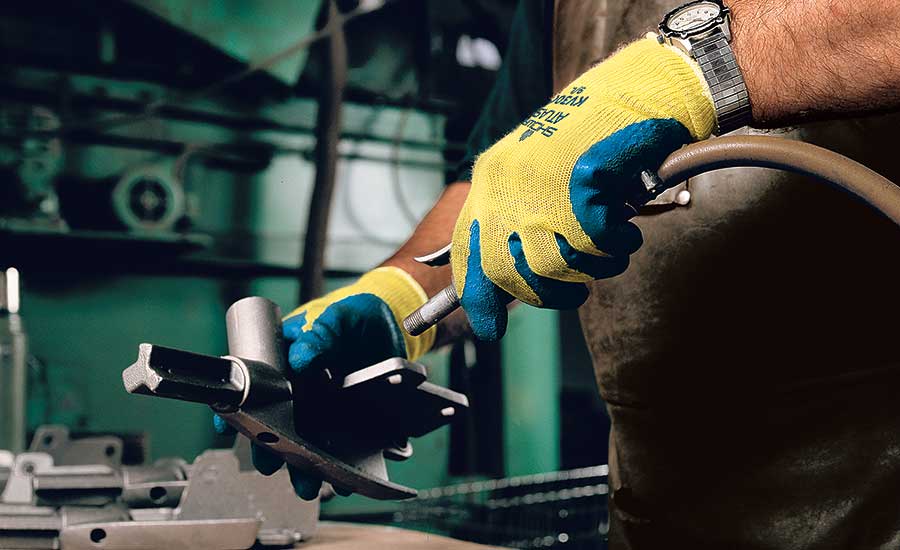Today’s protective gloves are made of materials, and by processes, which create gloves with superb levels of strength, versatility, functionality, comfort and protective resistance to cuts, chemicals and other hazards. But all those qualities can be wasted, or at least compromised, if people don’t know how to properly and safely fit, wear and use the gloves for the task at hand.
Fortunately, while no regulations or laws require them to do so, top-tier protective glove manufacturers provide comprehensive instruction and training in those how-to disciplines as a matter of course.
Typical training
Industry leaders have a knowledge-giving regimen that is a multi-faceted approach:
- Distributors are trained at a state-of-the-art training center, where the whole spectrum of appropriate personnel – from areas such as product management, research and development, and sales – are brought in to cover all the technical wear and usage considerations for single-use, specialty and general purpose gloves.
- Company personnel conduct hands-on training at a major end-user site using hazard assessments. After doing a glove evaluation with the safety director of the plant in question, gloves can be replaced – if they are found wanting – by newer- technology products that provide what was missing – e.g., a higher coefficient of friction for a general purpose glove that will give a better grip.
- The manufacturer visits its distributors to conduct events such as lunch-and-learn sessions, where new product rollouts are coupled with training and practice exercises for proper use of the gloves.
Unfortunately there are less-conscientious industry operators – what Gil LeVerne, Jr., SHOWA’s director of marketing, calls “imposters that simply import product and distribute based on price” – who don’t offer this kind of instruction and training. And, while the end-users of the gloves in the U.S. are required OSHA to inform their workers on how to use these gloves safely and effectively, that’s not the case for the glove makers and distributors.
The kind of standard training module that end-users, and some manufacturers, would provide cover how to properly don, doff, adjust and wear the gloves, as well as proper care, inspection and disposal of them.
Cut and chemical resistance
Safety Data Sheets may provide some information of this sort for chemical-resistant gloves, but for the most part it’s up to the manufacturer to do this – in telling customers the acceptable duration time for using a particular polymer glove in an environment that contains hexane, for example.
Instructions on how to use gloves can include disclaimers on how not to use them, too. One such caveat from a manufacturer will be that no glove is cut proof. That’s to guard against a situation where someone tries to demonstrate that a box-cutter can’t cut through a glove. For practical purposes, cut-resistant really means that the glove can protect against a glancing blow off of a sharp object, but not against enormous amounts of pressure.
It would seem that putting on a glove, whether it’s a fashion or work glove, would be simple enough. Some of it is common sense – knowing that a glove that’s too baggy or loose-fitting could make it harder to do a job effectively or get caught on something that could injure the wearer. But where chemical exposure is concerned, it’s really important to use simple language to tell someone how to put on and remove the glove. “You have to take special care on how you take that glove off,” LeVerne cautions. “Obviously you don’t want to take a bare hand and use it to take off a glove that’s been submerged into some type of harsh chemical.”
Need for standards & awareness
Just as instruction and training in wear and usage aren’t covered by regulations, neither are they rated by any type of certification or vetted by any standardized tests. LeVerne sees that as something that’s sorely needed “because a lot of companies couldn’t meet a rigorous standard.
“If there was some kind of standardization among all glove companies, where we could come together and agree on the type of training needed, and the kind of standard you’d have to meet, I think that would be enormous,” he says.
That dovetails into something else that’s lacking in the industry as a whole, namely, sufficient attention being paid to training, and the corollary investment of resources in training.
Accordingly, an OSHA study has found that 30 percent of manufacturing workers who suffered hand injuries sustained them, in part, because hand protection had been misapplied – a finding that suggests that workers haven’t been properly trained in how to wear and use their gloves. And yet, there is evidence that putting the necessary effort into instruction and training could be an important, value-add benefit that would influence end-users and distributors to purchase higher-performance, premium-quality gloves.



